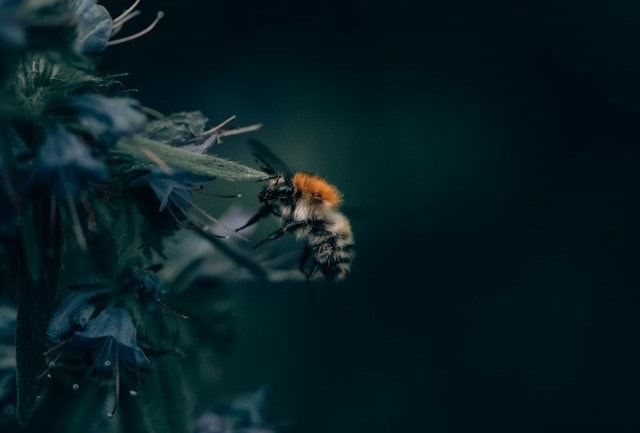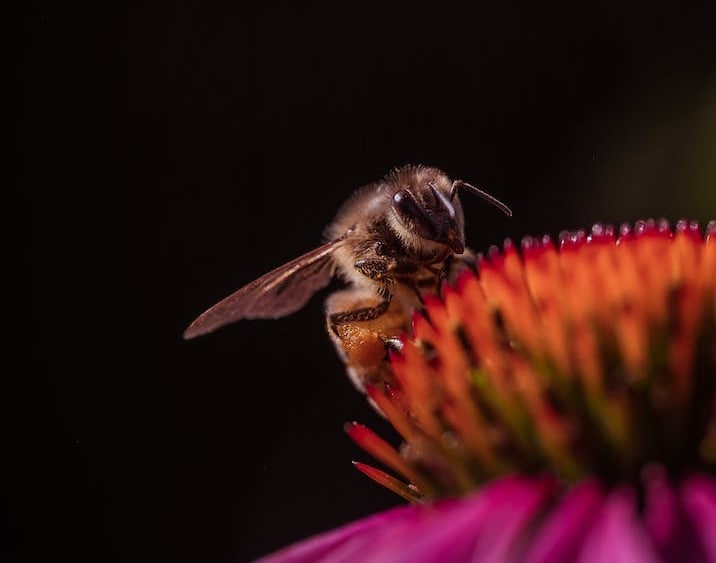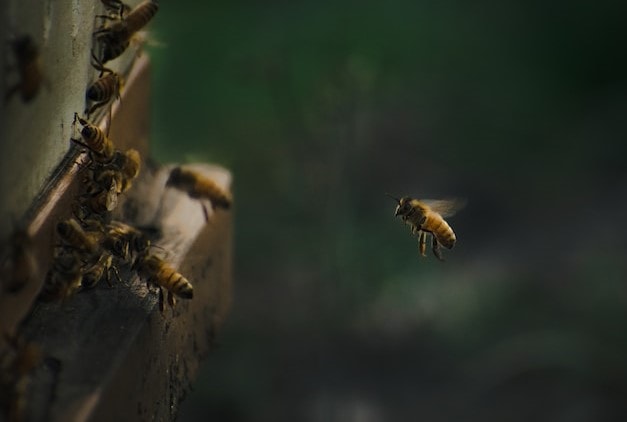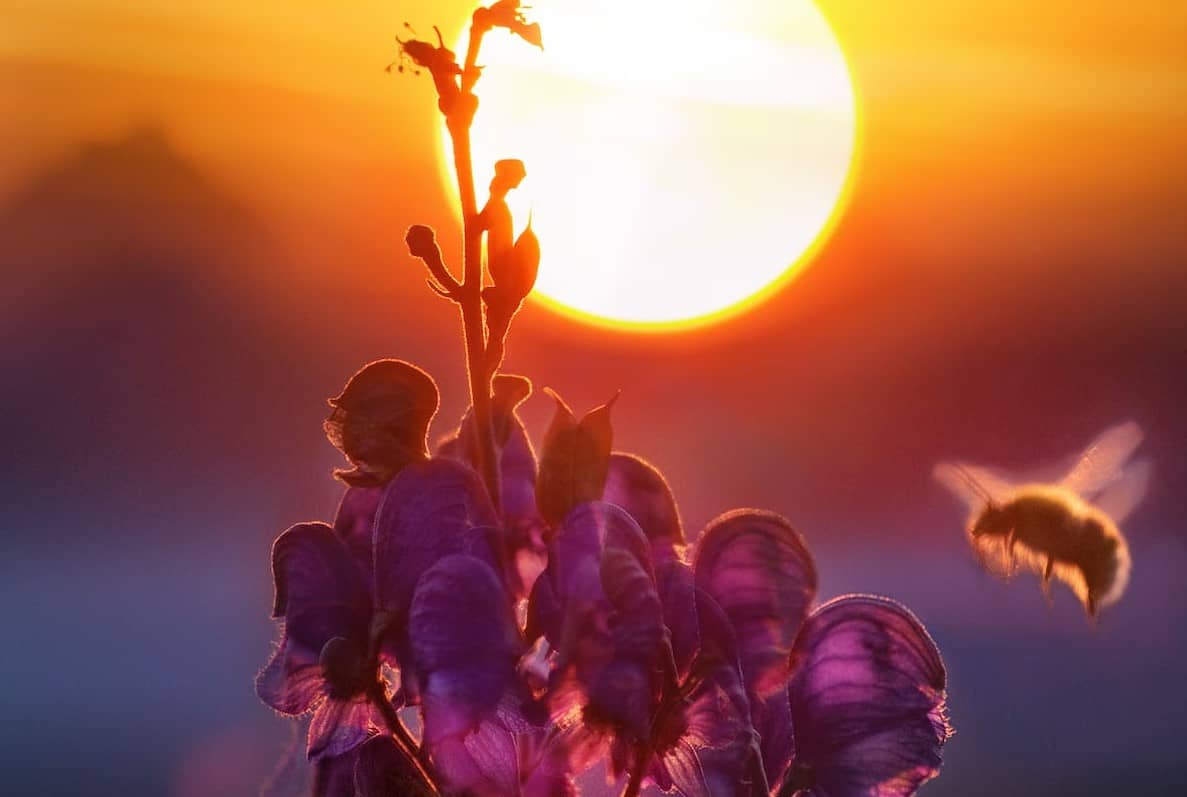During the daytime, we see bees foraging around and rendering pollination services, for which they are well-known. But during the night, do these bees also fly and forage in the dark?
Many people have asked the same question. Can bees fly at night? What do bees do during the nighttime?
In this blog post, we’ll explore the nocturnal activities of bees and whether they go flying in the dark.
Can Bees Really Fly at Night?

Bees are known for being industrious in the day as they help farmers and gardeners by pollinating crops and plants. But do they still do as much pollinating in the night?
The answer to this question depends mainly on the bee species. There are so many types of bees, and some of them can fly at night while others only fly in the daytime.
Types of Bees According to the Time They Are Active
Bees are not limited to being active only during the day. While most species of bees are active during the day, not all bees sleep or are inactive at night. Other bees come out after the sun goes down, and others are most active during the transitional periods of dawn and dusk.
Bees that are generally active during the day are called diurnal bees. Those that are awake and roam around at night are nocturnal bees. And crepuscular bees are those that are active during the periods of dawn and dusk when light levels are low but not completely dark.
Nocturnal and crepuscular bees have adapted and developed unique abilities to navigate and thrive in low-light conditions.
Diurnal Bees

Diurnal bees are those species that are active during the daytime. They are generally functional when light levels are high. These bees are well-known for their foraging activities, as they are often seen buzzing around flowers in gardens.
One of the most remarkable features of diurnal bees is their compound eyes, which are made up of thousands of tiny hexagonal cells (called ommatidia) that help create the image of the bee’s surroundings. The eyes of diurnal bees are able to detect color patterns that help them identify nectar-rich flowers.
The most common diurnal species of bees are honey bees, bumble bees, mason bees, and some sweat bees. We see these bees fly in our gardens, pollinating flowers one by one.
Nocturnal Bees
Nocturnal bees, as their name implies, are active at night. These bees have adaptations that allow them to navigate and find food in the dark of the night.
These night-flying bees may have larger compound eyes with many hexagonal facets. They may also have larger ommatidia, which increases their visual sensitivity to light. Some nocturnal bees, such as the Mexican honey wasp, have larger antennae that are more sensitive to smell. It helps them locate flowers or other sources of nectar and pollen, even in complete darkness.
One example of a nocturnal bee species is Megalopta genalis, a sweat bee native to South and Central America. These sweat bee species have larger facets in the eyes, making them more capable of seeing in the dark. Their brains are also believed to have specialized neurons that help them process the information they see in the dark.
Another example is the giant honey bee (Apis dorsata), known for its ability to forage for nectar at night. These bees have been found to visit nocturnal flowers, which produce nectar specifically to attract nocturnal pollinators.

Crepuscular Bees
Also known as twilight bees, these bees are active during twilight periods. This transitional period is important for these bees.
It allows them to conduct their foraging activity with less competition with diurnal bee species that are active during the day and nocturnal bees at night time.
The twilight bees may also have adaptations such as larger compound eyes or an increased ability to detect polarized light, which helps them navigate and locate food sources during low-light conditions.
They exhibit a unique foraging behavior that allows them to thrive in ecological conditions that are not suitable for diurnal or nocturnal species.
While nocturnal bees have larger, more light-sensitive eyes optimized for dim light conditions, diurnal bees have smaller eyes specialized for daylight vision, color perception, and spatial awareness.
Crepuscular bees exhibit characteristics that are intermediate between nocturnal and diurnal bees, allowing them to adapt to the unique light conditions during the evening dusk or early morning dawn.

Why Have Some Species of Bees Adapted to Flying at Night?
There are a few reasons why some bees fly at night. Studies are still being undertaken on this aspect, but here are a few common reasons why bees have developed certain adaptations.
Less Competition
Some species of bees have adapted to become night flyers as they take advantage of the resources that are available during the darkest hours, with minimal competition.
In the daytime, it is common to see so many bees and other day-flying insects foraging for nectar and pollen that the competition is so tight.
At nighttime, some competitors rest for the day. This is the best time to forage without running into a contest, giving the nocturnal bees more opportunity to find abundant food.
Fewer Predators
Some bees also prefer going out at night due to the lack of predators. Birds, skunks, honey badgers, and many others prey on bees. These bee predators are more prevalent during the daytime.
Even humans who are often fond of swatting on flying insects are asleep at night.
Knowing that they cannot fight against these predators, some bee species have adapted to being night foragers. In this way, they avoid any encounters with these predators.
Night Vision

Some bee species that are mostly active at night have evolved as night flyers because they are more capable of doing so.
These bees can see better in low-light conditions due to larger compound eyes and larger ommatidia. It allows them to see better with little light or in dim-light conditions.
Strong Sense of Smell
Another reason bees have become night foragers is that some bees have strong senses of smell and cannot resist plants that only bloom at night.
As an example, the plant Queen of the Night (Epiphyllum oxypetalum) is known to have nocturnal flowers. The flowers bloom only at night and wilt before dawn comes. The Queen of the Night flowers are also very fragrant and would attract bees from a few hundred meters away. Now, who can resist when you have that fragrance enticing your senses, right?
Can Bees Sting At Night?
The majority of bees are diurnal and are active during the day. Only a few bees are active at night. When you are worried about the thought of getting stung by a bee at night, chances are lesser since there are very few bees foraging at night.
However, if you happen to encounter a bee at night, there is still that chance of getting stung. Just like active bees during the day, nocturnal bees would not hesitate to sting you if they feel threatened or perceive danger coming to their hive or nest.
Nocturnal bees are also attracted to light. They rely on artificial light sources and moonlight to find their way to flowers to forage.
So, if you happen to bring a light with you when going out at night, you might attract a bee that could easily bump into you and feel threatened. In the process, it might sting you as a means of self-defense against what it perceived as a threat.
To minimize the risk of a bee stinging you at night, it is important to take some precautionary measures. When around light sources and bees land on you, move slowly. Avoid abrupt and sudden movements when in the presence of bees.
If a bee stings you, remove the stinger immediately and clean the stung area with soap and water. If you suffer from any allergic reaction, it is vital that you seek immediate medical attention.

Final Thoughts
While most bees are active during the day, some bee species can see well in the dark. These bees prefer to undertake their foraging activities at night.
The capability of bees to fly and forage at night shows their amazing ability to adjust to the environment.
These bees have evolved unique adaptations to help them navigate and forage during low-light conditions.
Their efficient visual acuity and adaptations are crucial for their survival and the pollination of plants that bloom during low-light conditions.
Bees have adapted to the environment in order to survive. It is essential that we also do our part to save the bees.
Let us all take steps to avoid a disruption of the bees’ natural behaviors and help save these essential pollinators.
Did You Miss These Beekeeping Posts?
